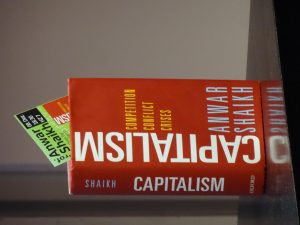Real Problems of Socialism and Some Answers
✑ PAUL COCKSHOTT` ╱ ± 13 minutes


Could a planning system work in a modern economy with a highly diversified product range? I and others have since the late 80s been arguing that the answer is yes.

Workplaces will have data that are as good as prices.

Could a planning system work in a modern economy with a highly diversified product range? I and others have since the late 80s been arguing that the answer is yes.
From: Paul Cockshott's Blog, Jan 13, 2017. ╱ About the author
Paul Cockshott (1952) is a computer scientist and Marxist political economist. In political economy, he has published several books on value theory, socialist planning theory and the econophysics models of production and money. He is now an honourary research fellow at the University of Glasgow, having retired from teaching. On twitter: @PCockshott.
In the post Soviet Period the left lost confidence in socialism. This was
partly a response to the immediate situation, but partly a realisation that
socialist economies had real problems. Since socialists themselves had not
come up with any real answers to these problems, and Western socialists
never went beyond platitudes here, the arguments of Friedman and Hayek
seemed to gain credibility. I will look at some of these real problems and
what the potential solutions are.
The main criticism levelled at the socialist economies was that a planned
economy was inherently less efficient than a market one, due to the sheer
scale of the bureaucratic task involved with planning a major economy. If
there are hundreds of thousands, or perhaps millions, of distinct products,
no central planning authority could hope to keep track of them all. Instead
they were forced to set gross targets for the outputs of different
industries. For some industries like gas or electric power, this was not a
problem. Electricity and gas are undifferentiated, a kilowatt is a kilowatt
– no argument. But even for another bulk industry like steel, there was a
wide variety of different rolled plate and bars, different grades of steel
with different tensile strength etc. If the planners could not keep track
of all these different varieties and just set rolling mills targets in
tons, the mills would maximize their tonnage of whatever variety was
easiest to produce.
The steel example is a little forced, that degree of differentiation was
still fairly readily handled by conventional administrative means. Tonnage
targets could still be set in terms of distinct types of steel. But when
you turn to consumer goods: clothes, crockery etc the range of products was
too big and targets were started to be set in terms of monetary output.
The plan would specify a growth in the value of output of clothing,
furniture etc. What this translated into then depended on the price
structure. In order to prevent other forms of gaming the plan by
enterprises it was important the the prices were economically realistic. If
the price for chairs is set too high compared to tables, it becomes
rational for factories to concentrate on chair production.
By resorting to monetary targets, the socialist economies were already
conceding part of Mises’s argument. They were resorting to the monetary
calculation that he had declared to be vital to any economic rationality.
Liberal economists argue that it was impossible for planners to come up
with a rational set of prices, only the competitive market could do so.
Planning required aggregation. Aggregation implied monetary targets.
Monetary targets required rational prices. Rational prices required the
market. But if you had the market you could dispense with planning.
Planning dialectically implied the super-cession of planning.
It is worth noting that this is a largely theoretical argument. It was, in
late Soviet days backed up with lots of anecdotal evidence, but empirical
evidence for the greater macro-economic efficiency of markets even when
compared to classical Soviet planning is much thinner on the ground. As
Allen, [2003
] shows, the only capitalist economy whose long term growth rate exceeded
that of the USSR was Japan, whose own model was some way from unplanned
capitalism. Compared to other countries starting out at the same economic
level in the 1920s, the USSR grew considerably faster. One could argue that
this was due to marcro-economic advantages of planning: that, by removing
uncertainty about future market demand, it encouraged a higher level of
investment. It is possible that this macro-economic advantage outweighed
any micro-economic inefficiency associated with plans.
The strongest evidence that markets may perform better than plans would
come from China, and that certainly the orthodox Chinese view. Their claim
is that a socialist market economy avoids the macro-economic instability of
capitalism whilst harnessing the micro-economic efficiency of the market.
As evidence they cite a higher rate of growth after Deng’s restructuring.
But China since Deng has followed a mercantilist road. It has the effect of
relatively beggaring the workers of China whose products are exported to
the US in return for US paper. The latter is of no benefit for the Chinese
workers, though it does enable private Chinese companies to buy up assets
in the US. From the standpoint of the Chinese state it is a more nuanced
issue. On the one hand Chinese state companies too, can buy up overseas
firms, but whether this is a long term advantage is a moot point since real
goods which could have been used to improve the Chinese economy and living
standards have been sacrificed.
Historically the process of having an export led economy allowed China to
avoid the technology bans that the West imposed on the USSR, allowing rapid
catch-up in manufacturing techniques. Now that China is overtaking the US
in some areas of mass production, that advantage is less clear, and a shift
towards higher domestic consumption and higher wages makes sense, and is
indeed being followed in China unlike Germany. It could be that the growth
advantage that China experienced post-Deng owed a lot to a new ability to
import the latest productive techniques instead of micro-economic
efficiency. But what is abundantly clear is that the pro-market
restructuring had the effect of drastically widening economic inequalities
and giving rise to a new domestic billionaire class. This in turn produces
political pressure to extend private ownership and undermine the still
dominant position of state industry.
So the question arises, could a planning system work in a modern economy
with a highly diversified product range, and how would it overcome the
socialist calculation argument of Mises. I and others have since the late
80s1
been arguing that the answer is yes.
The Mises critique of socialism focused on the need to compare the costs of
alternative ways of making things. Unless you can do that you can not chose
the most efficient. Our response has been not only that labour time in
principle an alternative, which Mises conceded, but that with modern
computer technology it is perfectly possible to maintain up to date figures
for the labour cost of each input to the production process. Using these,
workplaces will have data that are as good as prices for choosing between
techniques.
There are limitations to labour values as there are to any scalar measure
like price, since the constraints on production are multifactorial. Not
only labour power, but also natural resources and ecological considerations
constrain what we can make. No single scalar measure can handle this. But
the problem of how to deal with multiple constraints like this was already
solved by socialist economics way back in the 30s. Kantorovich came up with
a completely general technique for how to meet a socialist plan subject to
constraints additional to labour time
2
. Kantorovich’s method is an form of calculation in-kind, ie
non-monetary. It was not practical to use it at the level of the whole
Soviet economy during his lifetime as the computing resources were too
poor, but by the 1990s computers were up to the job. You can get a good
lay-person’s introduction to it in the novel Red Plenty by Francis
Spufford.
So the basic problem of socialist economic calculation without money had
been solved since Mises wrote. It was impractical in the USSR for two
reasons: a) the computer technology was not there; b) it would have
involved replacing money calculation and payment with non transferable
labour accounts. This would have been a radical step towards greater social
equality.
Labour time accounting demystifies or de-fetishizes social relations.
Rather than relations appearing to be between people and an objective
`thing’ called money, they make it evident that what is involved are
people’s lives. If I get with 1 hour of social credit for each hour I work,
and can for this credit acquire goods which themselves took an hour to
make, then it is clear that I am participating as an equal in social
exchange. If, instead, I am only credited with 40mins time for working an
hour, it is clear that there is something odd going on. If the difference
is made of a 33% income tax that I had a chance to vote on, that is one
thing. If instead I see that someone else is getting credited with more
than an hour for each hour that they work, I am going to be asking some
hard questions.
Labour time accounting has a presumption of equality and equity. If one
person gets credited more than they actually work, the a-priori implication
is that there is something dodgy about it. Its adoption would thus involve
a big pressure towards levelling. Levelling between different categories of
work, and levelling between men and women. It of course eliminates
completely the possibility of unearned capital income. It makes the moral
presumption that labour is the only legitimate source of income. Any other
income, to the old, the sick, to families with children has to be an
explicit voluntary deduction from the incomes of those who work.
The significance of labour tokens is that they establish the obligation on
all to work by abolishing unearned incomes; they make the economic
relations between people transparently obvious; and they are egalitarian,
ensuring that all labour is counted as equal. It is the last point that
ensured that they were never adopted under the bureaucratic state
socialisms of the twentieth century. What ruler or manager was willing to
see his work as equal to that of a mere labourer?
There is nothing terribly original in this scheme: set out briefly here,
but in much more detail in our other articles. It is simply a detailed and
literal elaboration of the proposals Marx made in his comments on the draft
of the 1875 program of the German Socialists.
The assumption is that people would have electronic labour credit cards
whose credits could only be cancelled out not circulated
3
. You could not pay credits into somebody else’s account but you could get
things form communal stores. This completely eliminates the possibility of
a black market.
It is absolutely essential that distribution labour values of goods be
realistic. A socialist government must avoid the temptation to undervalue
necessities in the communal stores. If they are undervalued, there will be
excess purchasing power in terms of labour credits. If bread used 300
million person hours to make but was sold for 100 million hours, an excess
of 200 million credits would have been issued to the bakers, millers,
farmers etc. Such undervaluation, we know from bitter experience, just
leads to queues and apparent shortages.
If prices are equal to labour content, then deviations of sales from actual
production can be used to adjust plan targets on a real time basis,
reallocating labour from products whose demand falls short of production to
those that are selling out.
Deviations from of distribution price from labour content would, however,
still occur in a planned economy for environmental reasons. If the planning
system had a constraint that total production of fossil fuel had to decline
by 2% a year, then the planning authorities would be forced either to raise
the distribution price of fuel above its labour content, or to ration
petrol. If petrol was distributed at a premium, goods which did not contain
fossil fuels would have to be distributed to consumers at a discount. There
might be a case for the environmental premiums or discounts being displayed
on the label.
Free communist distribution of goods and services is only viable for those
goods or services for which certain special conditions are met:
Socialist planned economy has a distinct form of surplus extraction. The
magnitude of the surplus is determined by the planned allocation of labour
between that devoted to the reproduction of the working population versus
other activities. This is the inverse of the mechanism that operates under
capitalism where the monetary division of the value added between wages and
profits comes first. In a capitalist economy the allocation of labour
between reproduction and other activities occurs as a second order effect
when the wages and profits are spent. In a socialist economy it is the
allocation of labour that comes first.
If the socialist country retains money, but delivers many services free,
has to balance the monetary demand in the hands of workers from their wages
with the amount of social labour going into consumer commodities. Since a
part of the social working day had been allocated to producing free goods
and services, and another part to the accumulation of new buildings,
infrastructure and machinery, the disposable income of the working class
had to be limited to the money equivalent of the number of hours spent
making consumer commodities.
There are a number of ways this could in principle be done:
But more serious than this, the policy of holding down wages and funding
public services out of profits had adverse effects on economic efficiency.
Suppose that 40% of labour goes on accumulation, 30% on free services and
30% on consumer goods. It follows that the wage has to be only 30% of the
real value of labour. The average wage for a 40hr week would only be the
monetary equivalent of 12 hours. This made labour appear to be artificially
cheap. If machinery was priced at full value, a rational factory management
would use 4 workers instead of one machine and 1 worker if the depreciation
of the machine amounted to 40 hours a week.
The Soviet solution of a turnover tax was short term populism that hampered efficiency.
This article was originally published on Paul Cockshott's blog. Visit his YouTube channel here.
1
Cockshott and Cottrell [1989], Cottrell and Cockshott [1993b], Cottrell et
al. [2009], Cottrell and Cockshott [1993a],Peters [2000].
2 The original paper was Kantorovich [1960], I explained for a modern readership how his technique worked in Cockshott [2006].
3 For a rather old fashioned idea of how this might work read Bellamy’s utopian socialist novel Looking Backward(1888). He invented the whole idea of credit cards. His cards were based on good 19th century punched card technology. You got a new card each month, and for each purchase from a social store an appropriate number of credits were punched out from your card. The store was envisaged as a cross between Argos and Amazon.
You selected goods from a catalogue at the store, and then they were delivered direct to your house by a system of pneumatic tubes.
Coordination
The only capitalist economy whose long term growth rate exceeded that of the USSR was Japan, whose own model was some way from unplanned capitalism
Equality
Labour time accounting demystifies or de-fetishizes social relations. Rather than relations appearing to be between people and an objective `thing’ called money, they make it evident that what is involved are people’s lives.
-
The actual allocation can be rationed by deliberate decisions or by
queues – this is how the NHS is able to function. You can get free
treatment but only if a doctor decides you need it, and you are willing
to wait your turn. This rules out, for example, resources being wasted
on penis or breast enlargement surgery.
-
Where the actual usage is easily pre-calculable. We know that demand
for primary schooling is set by the number of children reaching school
age. Making schools free increased demand up to this limit and no
further.
-
The resources being used would otherwise go to waste. Examples are the
free district heating provided in the USSR from waste heat of power
stations; providing free travel to pensioners outside of rush hours;
free use of Internet once the basic infrastructure has been installed.
Surplus
A direct deduction of income tax is more visible, but the converse of that is that something visible is easier to understand, and as a result easier to make open democratic decisions about.
-
By selling consumer goods at a mark-up or profit. This profit, since it
accrues to state factories, can then become government revenue and be
used to fund free services, accumulation etc. In the USSR this was
formalized as a turnover tax levied on all government factories.
-
By levying a sales tax, ie, one that is raised as a percentage of the
selling price like VAT
4
. Both this and the turnover tax are indirect taxation, they differ in
where they are collected: at production or at sale.
-
By levying an income tax or poll tax on employees. This was the
consistent policy advocated by Marx
5
.
- Mechanized production cost mis-valued at : 40 for machine + 12 for labour = 52
- Manual production cost mis-valued at : 48 for labour
- Mechanized production true value : 40 for machine + 40 direct labour = 80
- Manual production cost 4 x 40 hrs = 160 hours
The Soviet solution of a turnover tax was short term populism that hampered efficiency.
This article was originally published on Paul Cockshott's blog. Visit his YouTube channel here.
References
- [Allen 2003]
- Robert Allen.
Farm to factory: A reinterpretation of the Soviet industrial
revolution
. Princeton University Press, 2003.
- [Cockshott and Cottrell 1989]
- Paul Cockshott and Allin Cottrell. Labour value and socialist economic
calculation. Economy and Society, 18 (1): 71-99, 1989.
- [Cockshott and Renaud 2010]
- Paul Cockshott and Karen Renaud. Extending handivote to handle digital
economic decisions. In
Proceedings of the 2010 ACM-BCS Visions of Computer Science
Conference
, page 5. British Computer Society, 2010.
- [Cockshott 2006]
- W Paul Cockshott. Von mises, kantorovich and in-natura calculation.
Intervention. European Journal of Economics and Economic Policies
, 7 (1): 167-199, 2006.
- [Cockshott and Zachriah 2012]
- W Paul Cockshott and D Zachriah. Arguments for socialism. 2012.
- [Cockshott 2011]
- William Paul Cockshott. Comments on the “China model”. International Critical Thought, 1 (2): 148-157, 2011.
- [Cottrell and Cockshott 1993a]
- AF Cottrell and WP Cockshott. Towards a new socialism.
Spokesman Books, 1993a.
- [Cottrell and Cockshott 1993b]
- Allin Cottrell and W Paul Cockshott. Socialist planning after the
collapse of the Soviet Union. Revue européenne des sciences sociales, pages 167-185, 1993b.
- [Cottrell et al. 2009]
- Allin Cottrell, WP Cockshott, and Greg Michaelson. Cantor
diagononlalisation and planning. Journal of Unconventional Computing, 5 (3-4): 223-236, 2009.
- [Jones et al. 1979]
- Terry Jones, Graham Chapman, John Cleese, Terry Gilliam, Eric Idle, and
Michael Palin. Monty Python’s life of Brian. Hand Made Films,
1979.
- [Kantorovich 1960]
- L.V. Kantorovich. Mathematical Methods of Organizing and Planning
Production. Management Science, 6 (4): 366-422, 1960.
- [Marx 1970]
- K. Marx. Marginal Notes to the Programme of the German Workers’ Party
[Critique of the Gotha Programme]. Marx and Engels Selected Works, 3, 1970.
- [Marx and Engels 1977]
- Karl Marx and Friederick Engels. Manifesto of the Communist Party, trans. S. Moore. Moscow:
Progress.(First published 1848.), 1977.
- [Marx and Guesde 1880]
- Karl Marx and Jules Guesde. The programme of the parti ouvrier.
tomado de:
http://www.marxists.org/archive/marx/works/1880/05/parti-ouvrier.htm
, revisado el
, 2, 1880.
- [Peters 2000]
- A. Peters. Computersozialismus:Gespräche mit Konrad Zuse.
Vaduz, 2000.
- [Renaud and Cockshott 2009]
- Karen Renaud and Paul Cockshott. Handivote: simple, anonymous, and
auditable electronic voting. Journal of Information Technology & Politics, 6 (1):
60-80, 2009.
- [Renaud and Cockshott 2007]
- Karen Renaud and WP Cockshott. Electronic plebiscites. 2007.
- [Surowiecki et al. 2007]
- J. Surowiecki, M.P. Silverman, et al. The wisdom of crowds. American Journal of Physics, 75: 190, 2007.
Footnotes:
2 The original paper was Kantorovich [1960], I explained for a modern readership how his technique worked in Cockshott [2006].
3 For a rather old fashioned idea of how this might work read Bellamy’s utopian socialist novel Looking Backward(1888). He invented the whole idea of credit cards. His cards were based on good 19th century punched card technology. You got a new card each month, and for each purchase from a social store an appropriate number of credits were punched out from your card. The store was envisaged as a cross between Argos and Amazon.
You selected goods from a catalogue at the store, and then they were delivered direct to your house by a system of pneumatic tubes.
4 Note that the EU mandated VAT is in German mehrwertsteuer, literally
surplus value tax.
5 See Marx and Engels [1977], Marx [1970], Marx and Guesde [1880]
6 How to carry out such democratic budgeting is beyond the scope of this
paper but is a topic of our book- Cockshott and Zachriah [2012] and of
papers including Cockshott and Renaud [2010].
| Top image: Berlin wall paining. From: pixabay. |
|---|






















Comments
Post a Comment
Your thoughts...